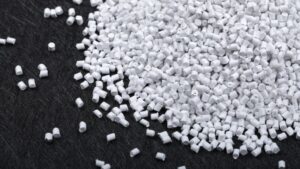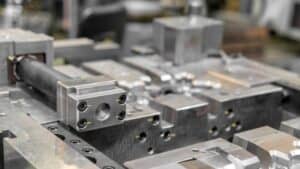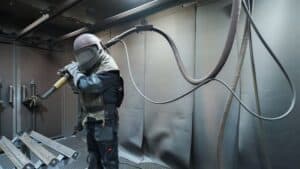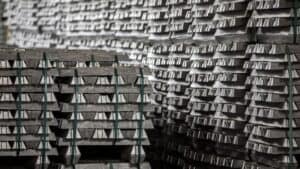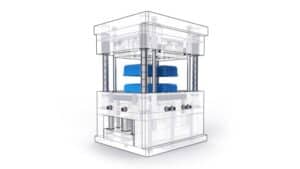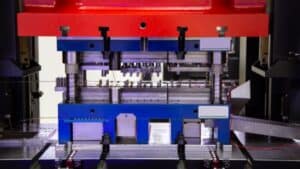Ceramic mold casting is a manufacturing process that uses ceramic materials to create detailed and accurate molds for shaping metal parts. This process stands out for its ability to produce parts with intricate designs, fine details, and smooth surface finishes.
Unlike many other casting methods, ceramic mold casting uses expendable molds and can handle metals that require very high temperatures. The technology is valued for both mass production and custom pieces, making it a flexible choice for many products. Readers interested in how everyday items and complex industrial parts are made will find that learning about ceramic mold casting reveals a unique blend of art and science in modern manufacturing.
Ceramic Mold Casting Overview
Ceramic mold casting uses ceramics to create detailed and accurate molds for making metal parts. The process combines features from plaster mold casting and investment casting and is used for items that need fine details and smooth surfaces.
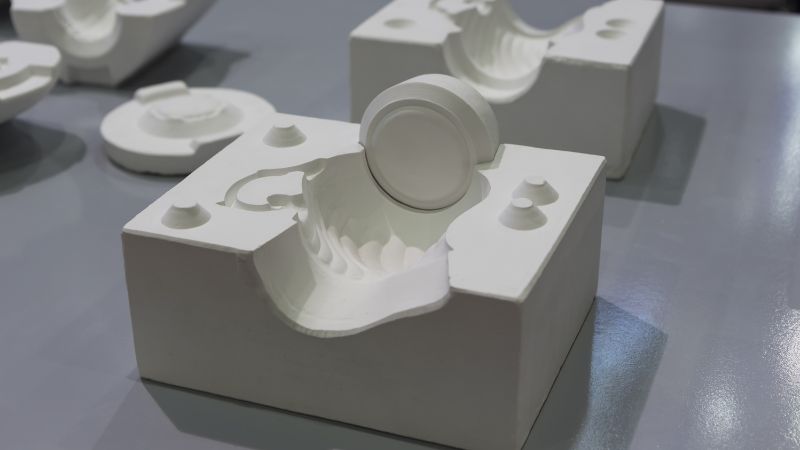
What Is Ceramic Mold Casting
Ceramic mold casting is a metal casting process where the mold is made using a special ceramic material. The method allows the creation of parts with complex shapes that would be difficult to achieve with traditional sand or plaster molds.
There are two main types of ceramic mold casting: the Shaw process and the Unicast process. Both involve pouring a ceramic slurry around a pattern to form the mold. Once the mold hardens, it is either burned or fired at high temperatures to strengthen it.
This type of casting is useful for making parts like drop forging dies, cutting tools, gears, bearings, and impellers. It is chosen when a smooth surface finish and tight dimensional control are important.
Key Materials and Components
Ceramic molds are made from a mixture of refractory materials and binders. The refractory material, such as silica or alumina, makes the mold heat-resistant and able to handle molten metal. Fillers are sometimes added to improve strength and reduce cost.
A reusable pattern forms the shape of the mold. The ceramic slurry, which includes fillers and a binder, is poured over this pattern. For the Shaw process, the binder may be hydrolyzed ethyl silicate and alcohol, which gels once poured.
Once the ceramic sets, the mold is further cured. Preheating helps control shrinkage when pouring metal. The ceramic material does not react with most metals, allowing it to be used for both ferrous and non-ferrous alloys.
Ceramic Mold Casting Process
Ceramic mold casting uses expendable ceramic molds to create metal parts with fine details and precise dimensions. The process involves careful mold preparation, mixing of ceramic slurry, curing by high heat, and pouring of molten metal.
Mold Preparation and Pattern Materials
The process starts by making a pattern that matches the exact shape of the final metal part. Patterns can be made from materials such as metal, rubber, plastic, or wood.
Patterns are designed to be reusable so that multiple ceramic molds can be made. The surface of the pattern must be smooth and clean to ensure a high-quality mold. Release agents are often applied to the pattern to make it easy to remove without breaking the new ceramic shell.
There are several ways to prepare patterns, including the Shaw process and techniques inspired by lost wax casting. Both allow for fine detail. The pattern is placed inside a flask, which provides support for the mold during later steps of the manufacturing process. At this stage, precise preparation helps avoid flaws later.
Mixing and Pouring of Ceramic Slurry
A ceramic slurry is a liquid mixture made by combining fine ceramic powders (such as silica, zircon, or alumina) with a binder and water. The composition of the slurry must be carefully controlled so it spreads evenly and forms a strong shell when solidified.
The pattern is dipped, coated, or poured over with the ceramic slurry. This layer starts out very thin. Multiple coats can be applied to build up thickness and strength. After each coat, the mold is left to dry so the ceramic particles can set.
The mixing ratio and drying times need to be consistent for uniform results. The final shell must be strong but not brittle to hold its shape when handled and during heating.
Firing and Curing the Mold
When the ceramic coating has dried, it is removed from the pattern to form an empty mold cavity inside the shell. The shell is then placed in a furnace for firing.
Firing hardens the ceramic and burns out any remaining binders or pattern residue. The firing temperature is usually high—reaching up to about 1,000°C. The mold might be heated first at a lower temperature to drive off volatiles, then fired hotter to fully harden.
A furnace or flame torch can be used for preheating. Proper curing is key because an under-fired mold can break during casting, while over-firing can make it too brittle. After firing, the mold is cooled in a controlled way to avoid cracking.
Pouring Molten Metal
Once the ceramic mold is cured and ready, it is often assembled if in multiple pieces (such as cope and drag sections). The next step is to pour molten metal into the mold cavity.
The most common metals used are aluminum, steel, bronze, copper, and specialty alloys. The metal is heated to the correct pouring temperature in a crucible or furnace before being transferred carefully to the mold.
The mold must withstand both the high heat and the weight of the metal. As the metal cools and solidifies, it takes the shape of the detailed cavity. After cooling, the ceramic shell is broken away to reveal the finished casting.
This part of the process is critical, as mistakes in temperature, pouring speed, or timing can affect part quality. Proper handling ensures that fine details and surface finishes are preserved from the original pattern to the final cast product.
Properties, Applications, and Design Considerations
Ceramic mold casting offers specific properties that affect the quality and types of parts produced. The process is known for handling high temperature pours and creating components with detailed shapes.
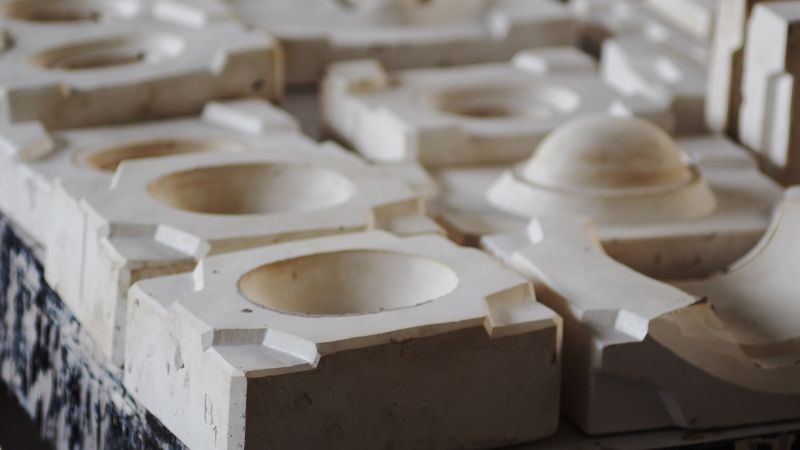
Dimensional Accuracy and Surface Finish
Ceramic mold casting produces parts with a smooth surface finish, often measured at 2.5–3.2 micrometers Ra. This fine finish reduces the need for additional machining and polishing.
The process achieves precise dimensional control, especially for thin sections and complex shapes. Molds made from ceramic can reproduce fine details from the wax pattern, making it suitable for parts with intricate geometries.
Ceramic molds have low permeability. This limits gas passage during casting but helps achieve better surface quality. Because the molds can withstand high temperatures, they are suitable for alloys such as stainless steel and bronze.
Types of Cast Components & Industrial Uses
Ceramic mold casting is used to create a wide variety of parts, including kitchen wares like kettles, industrial products such as impellers, gears, and bearings, and complex cutting tools. The method is also chosen for producing molds for plastic and metal forming.
Common applications include:
- Turbine blades
- Complex cutting tools
- Impellers
- Precision gears and bearings
Industries such as aerospace, automotive, and general manufacturing often select ceramic mold casting for parts that need tight tolerances and high surface quality. The process is especially valuable for small to medium-size runs where detail and material performance are important.
Designers should consider part geometry, as ceramic molds allow for sharp edges, intricate holes, and minimal draft angles. Thin sections down to 1.5 mm can be consistently produced, expanding the range of possible designs.
Frequently Asked Questions
What are the pros and cons of using ceramic mold casting?
Ceramic mold casting allows for detailed designs, smooth surfaces, and tight tolerances. It works well for making parts with thin cross-sections and complex shapes. This method is often used for both small tools and larger industrial components.
A main advantage is the reusability of the pattern and the quality of the cast finish. However, ceramic molds are not reusable, and the process can be more costly for large production runs. This method is best suited for small- to medium-sized batches due to these limitations.
Where can one purchase slip casting molds for ceramics?
Slip casting molds for ceramics are mainly available from art supply stores, specialty ceramic shops, and online retailers. Some local ceramic supply shops offer a range of plaster molds for hobbyists and professionals.
Online marketplaces and specialized suppliers offer many options in different shapes and sizes. It is important to check customer reviews, shipping costs, and return policies before purchasing.
What are the top considerations when choosing a ceramic mold manufacturer?
When selecting a ceramic mold manufacturer, key factors include product quality, accuracy, and material durability. They should provide clear information about their manufacturing methods and quality controls.
Reliable manufacturers offer customer support, clear pricing, and delivery times that fit the project timeline. Checking references or reviews can help confirm the maker’s trustworthiness and product consistency.

